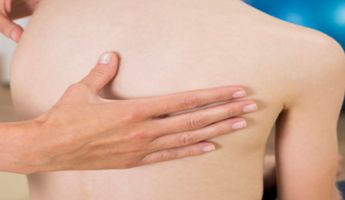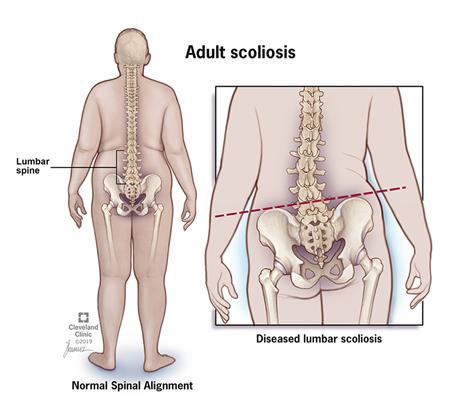Scoliosis Surgery in Romania
Search and Compare the Best Clinics and Doctors at the Lowest Prices for Scoliosis Surgery in Romania

Find the best clinics for Scoliosis Surgery in Romania
No clinics available
Morocco offers the best prices Worldwide
Price: $ 2,120

- Home
- Romania
WHY US?
At Medijump, we're making medical easy. You can search, compare, discuss, and book your medical all in one place. We open the door to the best medical providers worldwide, saving you time and energy along the way, and it's all for FREE, no hidden fees, and no price markups guaranteed. So what are you waiting for?

Free

Best Price

Widest Selection

Risk-Free
What you need to know about Scoliosis Surgery in Romania

Scoliosis is an abnormal curvature of the spine that occurs most before puberty during the growth spurt. Most cases of scoliosis are mild. However, it can get more severe, particularly as children grow. People with severe scoliosis may need surgery to treat their condition. Scoliosis surgery is the most extensive type of treatment for scoliosis. Besides for those with severe scoliosis, surgery may also be considered if:
-
The curve is getting significantly worse.
-
The curve is greater than 40 degrees.
-
The curve is interrupting your daily life and causes discomfort.
-
You experience severe back pain.
-
Other treatments have not helped your condition.
-
The nerves in your spine are being squashed or irritated.
There are several types of scoliosis surgery, including spinal fusion, growing systems (insertion of special rods), and fusion-less. The type of surgery you will get usually depends on your age and the severity of your scoliosis.
What does the Procedure Involve?
Spinal Fusion
Spinal fusion is by far the most commonly performed scoliosis surgery for teenagers and adults. This surgery involves fusing two or more adjacent vertebrae (the small, interlocking bones of the spine) together, which will cause the vertebrae to grow together at the spinal joint and form a solid bone that cannot move independently. This will limit the movement of your spine.
The vertebrae are fused together using a bone graft, screws, and rods. The rods keep your spine in a straight position, while the screws hold them in place. The bone graft and vertebrae eventually fuse together into a single bone. The procedure is typically performed under general anesthesia.
Fusion-less
Fusionless surgery is a relatively new approach to treating scoliosis. As opposed to spinal fusion, which limits movement and growth, fusion-less can preserve the movement and growth of your spine and this type of surgery is usually done on children.
Fusionless surgery involves applying constant pressure on the outer side of a spinal curve. It aims to slow or even stop the growth of the curve’s outer side, while the inner side can continue to grow normally. Over time, the lateral curvature should reduce as the spine becomes straighter.
Growing system (special rods)
In younger children, generally those under the age of 10, surgery to insert special rods alongside the spine can be done. The rods are anchored to the spine to help maintain or correct the spine’s curvature while the child grows. After 6 to 12 months, the child needs to return to their specialist to have the rods lengthened to keep up with their growth. This can be done in two ways:
-
Through a minor surgery in which the rods are extended through a small incision in the back.
-
Using a remote control that can activate magnets inside the rods. With this procedure, no cuts are needed to lengthen the rods.
This type of surgery is done in young children because if spinal fusion is done at too young of an age, it could cause several complications, such as less room for the lungs to develop.
How Long Should I Stay in Romania?
Although it depends on the type of surgery you underwent, you may need to stay in the hospital for two to seven days. Children may need to stay longer, usually for 10 days. It is recommended that you stay in Romania for about eight to ten more days for follow-up checkups and stitches removal.
What's the Recovery Time?
Full recovery can take about three to six months. However, school and work may be resumed after 4 to 6 weeks. Children may need to avoid sports roughly a year after surgery, while adults may need to avoid strenuous activities for a few months.
What About Aftercare?
After surgery, you may need to wear a brace to keep your spine in proper alignment. You may also need to learn new techniques to sit, stand, and walk safely. Physical rehabilitation is recommended to help you learn ways to move safely and to strengthen your back.
What's the Success Rate?
Spinal fusion surgery has a high overall success rate. The University of Washington’s Department of Orthopaedics & Sports Medicine reported that spinal fusion can achieve approximately 70% curve correction and has around 2 to 3% chances of complications when performed on someone under 16 with idiopathic scoliosis. However, the data for fusion-less surgery is not yet available.
As with any surgery, scoliosis surgery carries some risks, such as infection, pain, nerve damage, failure to heal, and excessive bleeding.
Are there Alternatives to Scoliosis Surgery?
If the scoliosis isn’t severe, your doctor may recommend the following:
-
Exercise – you can talk to a healthcare professional about an exercise program to strengthen and stretch your back.
-
Spinal injections – if scoliosis irritates or puts pressure on the nerves, your doctor may inject steroids to temporarily ease your discomfort.
-
Back braces – these are usually recommended for children, although adults may also benefit from using them. A back brace can help support your back and stop it from getting worse.
What Should You Expect Before and After the Procedure
Before scoliosis surgery, your scoliosis can be severe, cause pain, or prevent you from doing your normal activities. After surgery, you should be able to enjoy your daily activities without discomfort or pain.
Whilst the information presented here has been accurately sourced and verified by a medical professional for its accuracy, it is still advised to consult with your doctor before pursuing a medical treatment at one of the listed medical providers
No Time?
Tell us what you're looking for and we'll reachout to the top clinics all at once
Enquire Now

Popular Procedures in Romania
Prices Start From $3,084

Prices Start From $100

Prices Start From $200

Recommended Medical Centers in Romania for procedures similar to Scoliosis Surgery

- Interpreter services
- Translation service
- Religious facilities
- Medical records transfer
- Medical travel insurance
- Health insurance coordination
- TV in the room
- Safe in the room
- Phone in the room
- Private rooms for patients available

- Interpreter services
- Translation service
- Religious facilities
- Medical records transfer
- Medical travel insurance
- Health insurance coordination
- TV in the room
- Safe in the room
- Phone in the room
- Private rooms for patients available

- Interpreter services
- Translation service
- Religious facilities
- Medical records transfer
- Medical travel insurance
- Health insurance coordination
- TV in the room
- Safe in the room
- Phone in the room
- Private rooms for patients available

- Interpreter services
- Translation service
- Religious facilities
- Medical records transfer
- Medical travel insurance
- Health insurance coordination
- TV in the room
- Safe in the room
- Phone in the room
- Private rooms for patients available

- Interpreter services
- Translation service
- Religious facilities
- Medical records transfer
- Medical travel insurance
- Health insurance coordination
- TV in the room
- Safe in the room
- Phone in the room
- Private rooms for patients available

- Interpreter services
- Translation service
- Religious facilities
- Medical records transfer
- Medical travel insurance
- Health insurance coordination
- TV in the room
- Safe in the room
- Phone in the room
- Private rooms for patients available

- Interpreter services
- Translation service
- Religious facilities
- Medical records transfer
- Medical travel insurance
- Health insurance coordination
- TV in the room
- Safe in the room
- Phone in the room
- Private rooms for patients available

- Interpreter services
- Translation service
- Religious facilities
- Medical records transfer
- Medical travel insurance
- Health insurance coordination
- TV in the room
- Safe in the room
- Phone in the room
- Private rooms for patients available

- Interpreter services
- Translation service
- Religious facilities
- Medical records transfer
- Medical travel insurance
- Health insurance coordination
- TV in the room
- Safe in the room
- Phone in the room
- Private rooms for patients available

- Interpreter services
- Translation service
- Religious facilities
- Medical records transfer
- Medical travel insurance
- Health insurance coordination
- TV in the room
- Safe in the room
- Phone in the room
- Private rooms for patients available
Scoliosis Surgery in and around Romania
Introduction
Situated at the crossroads of Central, Eastern, and Southeastern Europe, Romania is a country of contrasts. From its medieval towns and castles, nature, and wildlife, to its rich cultural heritage and amazing food, this country continues to amaze its visitors. In recent years, Romania has become a flourishing medical tourism destination. Due to its low prices, well-trained medical staff, highly skilled doctors, and amazing medical centers, the country attracts an ever-increasing number of international medical tourists. Dental work is the number one reason medical tourists travel to this country, closely followed by cosmetic surgeries. Most medical tourists come from other European countries, such as the UK, Germany, other Western European countries, and the US.
Popular Cities and Regions in Romania
Almost every city in Romania has its fair share of amazing tourist attractions and skilled specialists. The most popular one is the capital of the country, Bucharest. This dynamic city boasts excellent museums, trendy cafes, and beautiful parks. Tourists usually flock to the Palace of Parliament, the Statue of Emperor Trajan, Cişmigiu Garden, the Romanian Athenaeum, and the Museum of the Romanian Peasant. Besides Bucharest, one of the most popular cities in the country is Brasov which is located in Transylvania; tourists usually come to this city as their base for trips to “Dracula’s castle.” The city is filled with charming medieval streets, great hiking spots, and a beautiful historic center. The second-largest city in Romania, Cluj-Napoca, is also famous for its bohemian cafes, amazing medical centers, and music festivals.
Transport in Romania
Henri Coandă International Airport is the busiest airport in Romania. It serves flights to various major cities in Europe, Africa, and the Middle East. Getting around Romania with domestic flights is fast, but can be expensive. The most common way to travel is by bus and maxi taxi (minibus), which reaches even the smallest towns.
Visas in Romania
While Romania is not yet part of the Schengen Area, the country’s visa policy is based on the Schengen acquis. Therefore, citizens of 62 countries, including the US and Australia, can visit and stay in the country for up to 90 days without a visa. Citizens of other countries will need a visa to enter. Those who already have a Schengen visa may enter the country.
Weather in Romania
Spring from March to May has fairly mild temperatures and pleasant weather. Summer, starting from June to August, is usually dry, sunny and sweltering. Autumn comes in September and ends in November. It brings enjoyable temperatures, but it is also the rainy season in the country. Winter, from December to February, can get quite cold and harsh with frequent snowfall.
Additional Info
- Local Currency: The currency is the Romanian leu (RON). 1 USD is approx. 4.7 RON.
- Money & Payments: ATMs can be found in major cities and smaller towns. Credit cards are widely accepted in restaurants and hotels. Tipping is expected in restaurants, hotels, etc.
- Local Language: There are several spoken languages in Romania. However, Romanian is the most spoken language. English is also spoken by around 31% of the population.
- Local Culture and Religion: Romania is a secular state with no state religion. However, Christianity is the biggest religion. Islam, Paganism, and other religions are also present.
- Public Holidays: New Year’s Day, Descent of the Holy Spirit, National Day, and Christmas Day are some of the most celebrated public holidays.
Popular Searches
- Plastic Surgery in Thailand
- Dental Implants in Thailand
- Hair Transplant in Thailand
- Breast Augmentation Thailand
- Gastric Sleeve in Thailand
- Gender Reassignment Surgery in Thailand
- Laser Hair Removal in Bangkok
- Botox in Bangkok
- Dermatology in Bangkok
- Breast Augmentation in Bangkok
- Coolsculpting in Bangkok
- Veneers in Turkey
- Hair Transplant in Turkey
- Rhinoplasty in Turkey
- Stem Cell Therapy in Mexico
- Rhinoplasty in Mexico
- Liposuction in Mexico
- Coolsculpting in Tijuana
- Rhinoplasty in Korea
- Scar Removal in Korea
- Gastric Sleeve in Turkey
- Bone Marrow Transplant in India
- Invisalign in Malaysia
- Plastic Surgery in the Dominican Republic
- Tummy Tuck in the Dominican Republic
- Plastic and Cosmetic Surgery in Poland
- Rhinoplasty in Poland
- Hair Implant in Poland
- Dental Implants in Poland
- IVF in Turkey